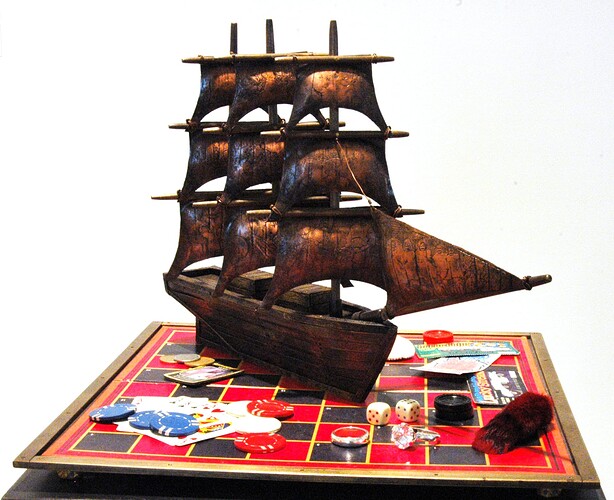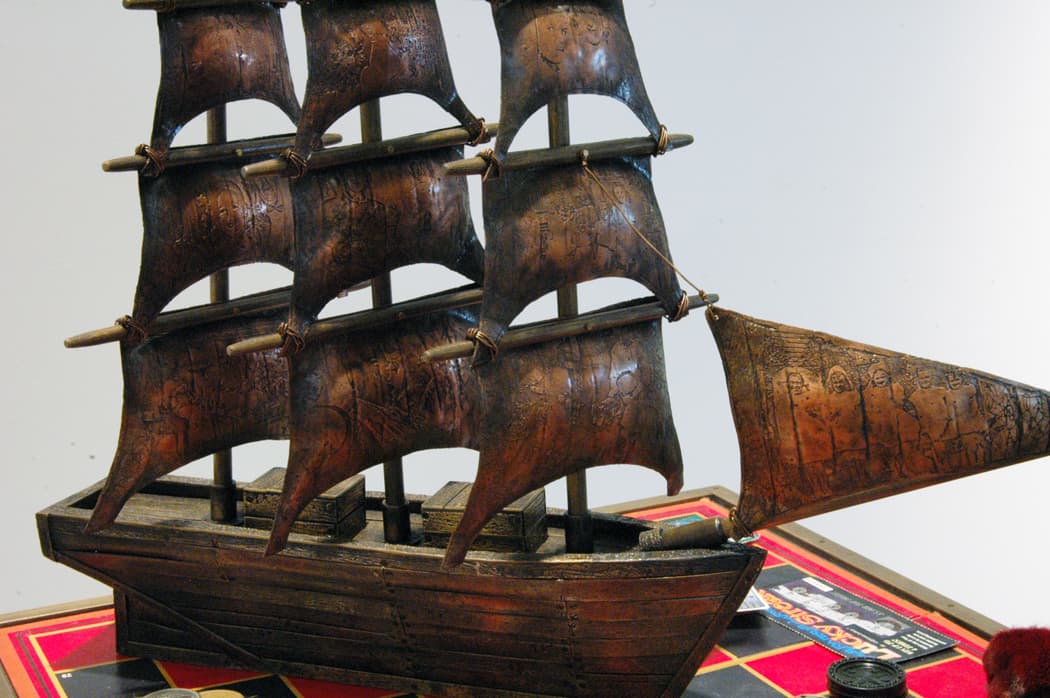Hi everyone! Sorry this is being published a little later than I wanted, but better late than never! Here is your Ask Me Anything with Jeff Georgantes! Feel free to respond to this thread with additional questions or comments.
JEFF GEORGANTES has an MFA in Jewelry/Metals from CSU, Fullerton and a BA in Art and an MA in Sculpture, both from CSU, Humboldt. He taught Art at College of the Redwoods, Eureka, CA, for fifteen years and has taught numerous visiting artist workshops across the USA. He helped develop and coordinate the Jewelry/Metals program at the Mendocino Art Center from the early 1990s until 2005 when he started his position as head of the Jewelry/Metals program at Dartmouth College, Hanover, NH. He has served on the Mendocino Art Center Board of Directors, the Metalwerx Board and the SNAG Board. Georgantes has also written number of articles for Metalsmith Tech Magazine. www.jeffgeorgantes.com
Personal
- When did you first discover your love for metalsmithing?
I was lucky enough to go to a high school that had jewelry making as part of their shop program. I was one of those kids that took a while to find something that interested me. All my friends had something that they were passionate about, but I wasn’t into sports, music, science, cars, or other things that kids my age were into. When I made my first ring, I felt like I had found myself. I don’t know how else to describe it. Everything about making jewelry just flowed and fit together. From there I kept going, literally for the rest of my life. I feel incredibly blessed to have found my life’s path from such a young age.
- Tell us about a favorite piece that you made.
That’s a hard one? Probably one of my sculptures? I’ve often approached sculpture from a jeweler’s perspective, meaning that they’re filled with intricate construction and minute details. My favorite piece is probably, “When My Ship Comes In.” It’s a piece that looks at my life as an assemblage of a variety of meaning full objects on a gameboard.
I was raised by a single mom. Lack of money was always an issue for us, and my mother would often say that we could get whatever it was, when our ship would come in. At some point in adulthood, I realized that I’d have to build my own ship and create my own path towards fulfillment of my dreams. (Like all of us.)
For the central object on the gameboard, the ship, I based that on a model wooden sailboat that a person from my childhood gave me. This person was born in 1900 and it was his grandfather’s boat when he was a kid. Which means this model ship is very old! It’s one of my most treasured possessions. Figuring out how to interpret the boat in metal was incredibly challenging, especially with all the compound curves that are in any boat.
I finally concluded that the only way to build the metal sailboat was similarly to how the original model boat was built. I soldered together a copper frame and photo etched a pile of “wooden” boards out of brass. I assembled the boat with zillions of 0-80 brass threaded screws that were hand tapped into the frame. For the copper sails, I photo etched historical images of my family.
- Tell us about your most challenging piece.
Technically, “When My Ship Comes In” was probably my most challenging piece, but here’s another challenging project. It’s an example of how jewelry can play an extremely important role in a someone’s life and what an honor it can be for the jeweler/maker to make that jewelry object.
Before I moved to the East Coast, for about 30 years, I lived in small, rural coastal fishing town at the top of California, 20 miles from Redwood National Park.
One year, fishing in our area was bad and a local captain took his fishing boat up to Alaska. Sadly, the boat sank up in Alaska and the crew died. Obviously, the captain’s wife and family were devastated. Somehow, I got recommended to the family to create a series of pendants to hold the captain’s ashes.
It took several emotion-filled conversations to create a concept. The goal was to build some kind of meaningful pendants that held the captain’s ashes close to the hearts of those who loved him.
We decided that I’d make a series of hollow pendants emulating a smooth ocean rock that were cast from bronze that was salvaged from the sunken boat.
To make the pendants, I made a liquid rubber mold of an ocean rock. I filled the mold with injection wax. Then I cut the solid wax in half and hollowed it out with wax burs. After that, I made another mold again of the two halves, so it would be easily castable. From there, I cast the two halves in the salvaged boat bronze and soldered them together.
To get the ashes inside, I drilled and tapped a small hole at the bottom of the pendant, inserted the ashes and plugged it with a small, counter-sunk, brass bolt with Loctite.
To this day, if I ever run into this person, I get a hug. It was truly an honor to have been able to facilitate another person’s vision of such a meaningful object.
- If you weren’t a metalsmith, what other career would you have pursued?
I don’t even want to think about what my life would have been like if I hadn’t found jewelry and metalsmithing! It’s essentially been my life’s focus since I was a teenager. Since I graduated from college in the late 1970’s with a degree in Art, I’ve only ever worked as an artist, art teacher or art administrator. It’s been an amazing ride and I can’t imagine any other path for me.
- Where do you find inspiration?
I grew up in the SF Bay Area, but as soon as I got out of high school I moved out of the city. I’ve never lived in a city again. I try to spend as much time as I can outdoors. I get most of my inspiration from the natural world and the introspective thoughts that happen on my daily outdoor excursions.
Technical
- I am a bench jeweler and I do not have a spot solder tool. My question as a bench jeweler is Do you have and techniques for soldering on jump rings for earrings without melting the jump rings with an acetylene torch? – Robert McFadden
Here’s some tips.
First, it sounds simplistic, but wear magnification (like an optivisor), look carefully and learn to read the materials. Before brass, copper, silver, or gold melt they turn red. Once you put a torch to your jump ring & earring and see the tiniest hint of red, know that your metal could melt soon. Pull away the torch before it melts.
I’m a big fan of white paste flux for beginners. Going with the “learn to read the materials” idea, paste flux not only keeps the metal clean while heated, it also is an excellent temperature indicator. Paste flux goes through several stages as it’s heated before the solder melts. The first stage as it’s heated up, is that paste flux is white powder (a boric acid mixture) and water. Next the water evaporates and it’s a crusty white powder. The stage after that, the flux becomes kind of black and globby. After that it flows and becomes water or glass like. Solder should melt soon after the flux becomes water or glass like.
Second, don’t use too much flux. Too much flux can be a heat barrier which can make the process more difficult.
Finally, sometimes an easy way to solder jump rings onto an earring in many circumstances is to put them both flat on a soldering block with a small chip of solder underneath the joint and a tiny bit of flux. Heat them from above and watch the solder flow up into the joint. (That’s how I often solder band rings as well.) The solder block acts as a heat sink, which can slow down melting of your parts.
If you need to solder jump rings closed that go through a hole in the earring, often you can manipulate the self-locking steel tweezers to act as a heat sink.
Remember the biggest “trick” is to learn to read the materials, paying attention to what the flux is doing and the heat color of metal.
- Do you know of any books/ articles or can you give me some hints on doing keumboo on steel/iron? I have done keumboo on silver. – Sandy Essex
I’m not an expert on Keumboo, so I reached out to my friend Paulette Werger, who often teaches Keumboo workshops. Here’s what Paulette said:
Gold fusion on steel, yes. My opinion is that it’s technically not Keumboo. Bette Barnett teaches “Keumboo” workshops on steel in silver and gold. Studio Migato and FB group Gold on Steel exist for exchange of information as well.
- Some rings are not precisely symmetrical and have been designed to be worn on the left or on the right hand. What is the difference between the design of these and more traditional (i.e., symmetrical) rings? – Arnold Gulub
I’m sorry! But I don’t understand this question. Can you tell me more?
Message for Jeff
- Gerry Lewy looks forward to information and experience sharing with you.
Thanks Gerry!

